
I have to hand it to the guys at Gracias a Dios (GAD) or www.thankgad.com – that is one clever URL for the brand.
I had a chance to visit their palenque – a two birds with one stone event so I could see my friend Norma and visit the palenque. She lives in Teotitlan and puts on some pretty incredible textile and culture tours.
We set up a time to meet at the GAD palenque and get a special tour and tasting with Maestro Mezcalero Oscar Hernandez Santiago. Of course I got lost because my GPS disconnected and the directions sent us off in the complete opposite direction in Matatlan. Note to travelers – google maps is great and amazing, except of course when you have no phone reception which crazily enough, I didn’t in Matatlan. The palenque is on the edge of town as you head south on 190. It is a beautiful piece of property and will eventually be a centerpiece of the new style of mezcal travels in Oaxaca – a bread and breakfast on palenque property. It is now available to book through Airbnb.

Don Oscar is a part owner of Gracias a Dios – an uncommon thing in the business of mezcal brands. He and his three partners have an equal stake in the business, meaning it joins the ranks of a handful of other brands where the maker is part of the business– Real Minero, Rey Campero, Wahaka, Tosba, Vago, and Casa de Cortes are others. (Note – if you know of others that are available in the US market, please share as we get asked this all the time.)
Don Oscar is an incredibly warm and friendly man. He has a huge smile and open demeanor, not the usual reserve you find with many mezcaleros who can sometimes take more than a few minutes to warm up to people. He is eager to talk about the mezcal and the flavors and why they have done what they have done. We sit first at the small bar at the front of the palenque so we can taste before doing the tour. A representative with the Consejo Regulador del Mezcal, known locally by it’s acronym CRM, is there, retrieving samples of mezcal for testing. There is activity around bottling, labeling, packing cases, and wrapping them on the pallets, ready to be trucked to market. Like most other palenques, everything is done by hand, creating jobs for the area.

We start with the espadin, then move through the others, tobala, cuishe, tepextate until arriving at two that differentiate this brand from others – a mezcal gin and a “summer mezcal” made with mango. Pierde Almas was the first brand to bring a mezcal gin to market. It is a regular espadin that has been triple distilled with gin botanicals. I can’t drink gin but love the botanicals flavor, so a mezcal gin is perfect for me. I don’t even need to make a cocktail with it, though I am sure it would make me a martini drinker, olives and all. I bet it would also make for a nice bloody maria. The mango mezcal had a nice light flavor to it and like the clever URL, selling a mezcal as a “summer” release is kind of brilliant. I hear the collective groan from all you purists, but this is the future of the market to a certain extent.
A side note on palenque visits and having a 13yr old. My son Isaiah has seen his share of palenques at this point and as a teenager is easily bored. We were able to not only find a bike for him to ride around on, but also one of the ranch dogs made Isaiah his new BFF. We were all taking bets on who would tire out first. Hint – neither ever got tired.

After the tasting we moved on for the tour. The palenque is beautifully laid out, with plenty of open air and ease in moving around. Currently, Don Oscar produces about 3,500 liters a month. His nephew produces the mezcal gin at around 1,000 liters a month. They have capacity to do more and are planning to be at about 5,000 liters a month by the end of the year. They will add an additional still and fermentation tank to increase production.
Don Oscar is committed to maintaining a traditional and artisanal process. The only variation to that, which in no way would reclassify it as a “mezcal” under new labeling, was a hand rigged water cooling system for the distillation tanks – someone is clearly a tinkerer on site. The palenque itself is juxtaposed with its neighbor on the property – Sombra. Don Oscar’s brother is the maestro mezcalero for that brand and they share the property equally. The quiet calm of the GAD palenque is in contrast to the activity at Sombra where they are building out the space. That the brothers are taking different approaches is interesting. Sombra intends to be a sustainable volume production, as we wrote about here, while GAD will take the traditional production road and keep the volume smaller. Only time will tell if volume demand pressures will have them re-thinking this approach like everyone else in the industry.

After the palenque tour, Don Oscar walks me through some of the agaves he has planted. There is the “show” garden with identified types of wild agaves, there is a small plot of tepextate seedlings, and then several rows of an agave variety found in the Yucatan, Veracruz, and Tamaulipus – called henequen. The agave fibers are also known as sisal, and are used for rope, twine, etc production. It was huge industry in the 19th and 20th century, when there was great demand for the fibers because if its durability and strength. Then synthetics came along and sidelined much of the industry because of lower cost. Its juice is used for agave nectar and for making a liquor. It is also used in pharmaceutical drugs. Most of the henequen I have tasted is lower in alcohol, coming in at about 38% and aged. There seems to be more coming into the market as demand for mezcal has surged and interest as grown in Mexican distillates overall.
We walk back to the palenque where I try and gather Isaiah – he and the dog are still running around, say goodbye to Norma, and get us in the car to head back to Oaxaca. There is the smell of rain in the air and I am hoping we can get back to the city without getting stuck in a deluge – July rains are no joke here and when the sky opens up it is with a heavy downpour that very quickly inundates everything. The conversation topics on the ride home are all over the place – how many miles per hour can a goat run, could Isaiah out run one, why do topes exist in the first place, why do people actually like mezcal, and how much do mezcaleros make. We manage to avoid the traffic jam for the Lila Downs concert, and arrive in time to return the rental car that night. It was a good day.







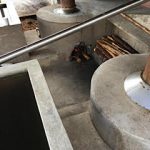
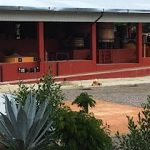


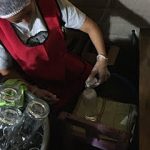


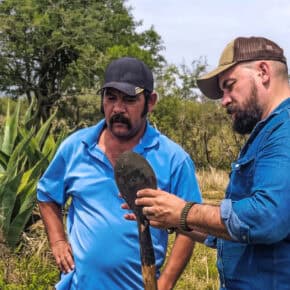
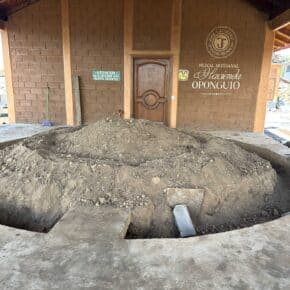








Leave a Comment